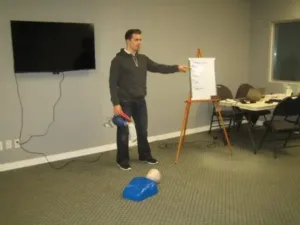Cardiopulmonary resuscitation (CPR) training is available all throughout America, offered by different training providers. Guided by the principles set by the American Heart Association (AHA) and the concept of ECC – Emergency Cardiovascular Care – CPR training teaches trainees how to help victims of cardiac arrest improve their chances of survival. CPR courses can be learned by anyone – whether you’re a health care worker or not.
Course content
Emergency Cardiovascular Care (ECC)

The AHA’s ECC program is focused on the message of hope and saving lives. Because of this, the latest techniques are taught to students to further improve survival rates of victims of cardiac arrest and their quality of life after the attack. Not only is the ECC program dedicated to symptomatic treatment and management of a cardiovascular emergency, public awareness is also a concept tackled in the CPR training program.
The mission of the AHA ECC program is to reduce disability and mortality from cardiovascular and respiratory emergencies – including but not limited to stroke and cardiac arrests. Through the up-to-date chain-of-survival taught by the AHA, rescuing victims has become more effective and efficient.
Cardiopulmonary resuscitation (CPR)

CPR training is focused on the chain-of-survival in handling victims of cardiac arrest. The chain is composed of different steps; following the chain has been seen to contribute to better survival rates and quality of life of rescued victims. The skills taught in a CPR training program are two basic parts of CPR: chest compressions and rescue breaths.
Students train on adult and pediatric training mannequins in order to improve their CPR skills. The latest mannequins are made to act like actual human bodies, so the chest recoil and flexibility of the mannequin is similar to a human’s. The mannequins are also used to practice giving rescue breaths and tilt and jaw thrust maneuvers.
Automated external defibrillation (AED)
Automated external defibrillators are small machines that are hooked to the chest with removable chest pads. Electrical shock is sent through the pads to the heart, in order to help is restart in the event of a cardiac arrest. All CPR classes teach students how to use AEDs, if ever one is available during rescue.
Course details
CPR programs are typically 4 hours long. Once the program is completed, students receive a CPR and AED course completion card that is valid throughout the US. In order to pass, a skills test and a written exam are given to students.
There are also CPR programs that are tailored towards health care workers. These classes last between 4 and 4 and a half hours. CPR programs for health care workers are tailored towards a health care environment such as a hospital or an out-patient facility. Skills such as one-rescuer and two-rescuer techniques are taught to students. Again, students need to pass a skills test and a written exam in order to pass the program.
For whatever reason a student may have, there are CPR programs that are available to him or her. Programs are very flexible in terms of scheduling (and sometimes class length) so you’re sure to find one that suits your needs best.

Hi! Just want to confirm, are you AHA accredited? How much is the BLS course and when is the next available class?
Hello!
Do you have any AHA approved BLS or ACLS courses?
Thanks!